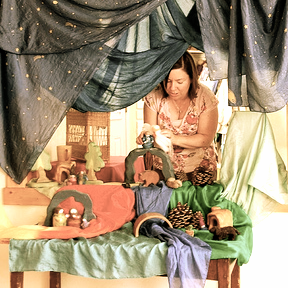Waldorf educates the whole child — head, hands and heart.
Waldorf Schools Break Tradition
A Waldorf school is a living, breathing place. Our classrooms are indoors and out.
When you enter a Waldorf preschool, you’ve entered an imaginative, magical place where childhood is protected and celebrated, pure and simple.
Walls are hand-painted in lovely, soft colors and adorned with student artwork. Fresh bread or wholesome granola is baking in the oven. The school is awash with the sounds of stories, laughter and songs. Inside and out, you’ll see little altars for the fairies, fresh flowers, gourds and pumpkins and evergreenery celebrating the season at hand. Natural textiles and wooden toys are tucked into cubbies. All day, every day, imaginations are free to wonder, develop and play.
In the Waldorf tradition, learning takes place through experiences, and children learn to cultivate a lifelong love of learning, intrinsic motivation, and the confidence they need to grow into individual identities.
We Meet Children Where They Are
Teachers in Waldorf schools are dedicated to generating an inner enthusiasm for learning within every child. That enthusiasm is a form of joy, and it allows motivation to arise from within and helps engender a lifelong love of learning.
The Waldorf approach works with human nature and recognizes that children develop, like butterflies from a cocoon, at fairly predictable stages. Yet, just as some wings require more sunshine before they are strong enough to fly, we also allow room for individual rates of maturation. This appreciation for the metamorphosis of early childhood underlies the way we guide and care for every child.
Our teachers are interested in the students as individuals. They are interested in the questions:
- How do we establish, within each child, his or her own high level of integrity, authenticity, and excellence?
- How do we call forth enthusiasm for learning and work?
- How do we call forth every child’s healthy self-awareness, interest and concern for fellow human beings, and a respect for the world?
What’s Unique about Waldorf Early Childhood?
The preschool and Early Childhood teachers in a Waldorf school work with young children by creating a warm, beautiful and loving home-like environment. Classrooms and learning environments are protective, “held” and secure, and our children can count on predictable, regular rhythms. They can also count on plenty of free play and lots of time outdoors, rain, snow or shine!
Waldorf Early Childhood teachers engage with children in three basic ways:
- Imitation: The teacher engages in domestic, practical and artistic activities that the children can readily imitate (e.g., baking, painting, gardening and handcrafts). These activities are adapted to The Three R’s, the changing seasons and festivals of the year.
- Imagination: The teacher nurtures the children’s power of imagination. Teachers tell carefully selected stories and encourage free play. This free or fantasy play, where children act out scenarios of their own creation, helps them to experience many aspects of life more deeply. When toys are used, they are made of natural materials. Pine cones, wood, cotton, silk, shells, stones and other objects from nature are often collected by the children themselves, and they are used in play and to beautify the room.
- Intimacy with Nature: In the words of Sharifa Oppenheimer, author of Heaven on Earth, “The child readily comes to know their own bodied-ness when in intimate connection to the body of the earth. Running, swinging, jumping, creeping, sliding, kneeling, splashing, digging…all of this develops familiarity with and fullness ‘in the body.’ The child develops strength, balance, agility, grace, flexibility, competence and confidence. This kind of ‘body-knowing’ lays a foundation for all of these qualities to permeate the child’s whole being. Years later, the young person steps into the world with these capacities intact and readily available for the challenges and joys of adult life. …Much research has been done, observing children’s play in both natural spaces, and in built spaces.”
Sequencing, sensory integration, eye-hand coordination tracking, appreciating the beauty of language and other basic skills necessary for the foundation of academic excellence are fostered in mixed age classrooms and both pre-K and Kindergartens. In this truly natural, loving and creative environment, children learn from a range of meaningful, valuable activities in an educational structure that helps them enjoy the magic of childhood while still preparing them for the next phase of life, including grade school.
The above content is adapted from the Association of Waldorf Schools of North America (AWSNA) online.


